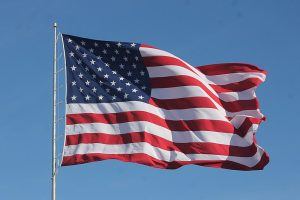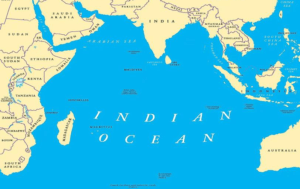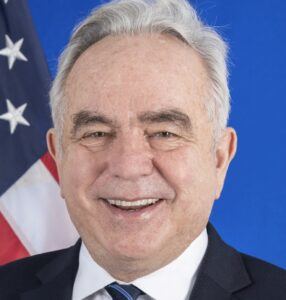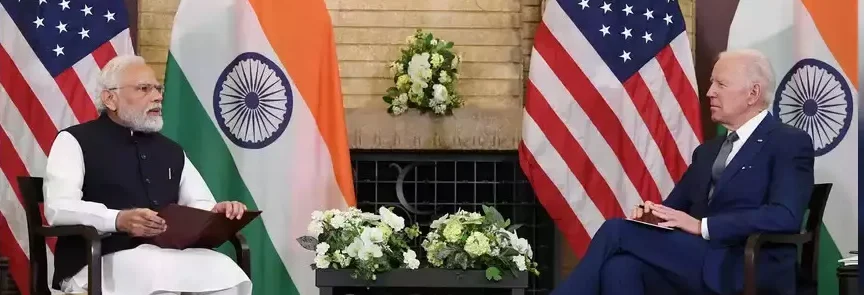What National Security Advisor
OpenLife Nigeria reports that Kurt Campbell, Deputy Secretary of State just returned with the National Security Advisor, Jake Sullivan, from a series of engagements in India.
The purpose of the meeting centred on the partnership between the United States and India.
For the record, the United States and India are working increasingly closely together on issues of mutual interest and concern in the Indo-Pacific.
At the meeting therefore, discussions revolved around the next steps for multilateral engagement.
In his preliminary remarks in the media parly organized by London International Media Hub at [email protected] Campbell gives insights into the major issues at the meeting saying:
The United States and India want to take next steps with respect to the Quad. We’ve also talked about the Bio-5 and the specific initiatives that we’ve had between the United States, the ROK, and India in technology, and increasingly, India’s role in these many-lateral engagements is central and critical.
We also made plans for launching an ambitious Indian Ocean set of deliberations between the United States and India, which will incorporate not only key players at the center of the prime minister’s office and the National Security Council, but also players from the State Department, the Defense Department, and our respective naval departments as well.
So we’re looking forward to those discussions. We think the Indian Ocean is a critical venue for us to deepen our cooperation and dialogue.

I do want to just say, though, at the heart of this was really our discussions around technology, and India is really in that very small group of countries that we work most intimately with on technology.
And since iCET’s official launch in January of 2023, we’ve, frankly, deepened strategic cooperation across a whole venue of arenas: space, semiconductors, advanced telecommunications, AI, quantum, and biotech.
And so these sessions with Jake Sullivan and his counterparts, NSA Doval and others in the prime minister’s office and the Ministry of External Affairs, gave us an opportunity to do a full accounting of where we are and then also set some ambitions for what we want to do going forward.
I think we all recognize that technological leadership is really increasingly the high ground for national power, geopolitics, and it is at the heart of strategic competition.
It is our great differentiator in our foreign policy approach, and we’ve been deeply engaged with Indian partners on seeking to build technology into the very fabric of our cooperation with them going forward.
We also believe that iCET offers the opportunity to blend not just our government engagements but to incorporate key players in the private sector, developing and broadening the engagement across our societies.
For instance, the $90 million for the U.S.-India Global Challenges Institute. This is really high-impact university research, and it suggests that India will increasingly play an important role in critical tech supply chains and clean energy.
I think, while we were there, we also had an opportunity to engage a very high-level delegation from Congress. HFAC speaker or Chair McCaul, Ranking Member Meeks, Speaker Emeritus Pelosi were in India for discussions with the Indian Government.
I’m pleased to say that this is one of the relationships that enjoys broad and deep bipartisan support for, and so we were able to compare notes on issues that we were seeking to build on going forward.
So I just want to underscore that I think since the important state visit last year, we’ve been able to sustain momentum in the U.S.-India relationship. We’re broadening our areas of engagement.
I expect that there will be other avenues for deeper cooperation going forward. I think each side expressed interests in working more closely together in Africa, given India’s increasing role there, and obviously in the Middle East and Gulf, India’s role has proven increasingly important.
In our discussions, we were able to review really every global arena of importance, both regionally and strategically.
And I think it was just an important reminder of the advances that we’ve seen in the U.S.-India relationship since the beginning of the Biden administration, but frankly, building on the successes of previous administrations.
I said at an earlier session this week that in, I think, all respects the U.S.-India relationship is – has basically reached escape velocity and it is among the most important endeavors that we’ve engaged in.
I’ve said before that I think India will be our key partnership for the 21st century, and I stand by that.
So that’s in the way of discussions. We have a very crowded agenda with India going forward, lots of return visits and engagements later this year, and we’re pleased to see the enthusiasm for the U.S.-India relationship to continue.
Questions from journalists
Rezaul Laskar of the Hindustan Times
What concrete action will the United States take in the coming months to remove barriers to bilateral strategic technology trade?
Look, it’s an important question, and I think basically since the launch of iCET in January of 2023, the United States and India have really taken significant strides towards deepening and expanding strategic cooperation really across key technology sectors, including space, semiconductors, advanced telecommunications, artificial intelligence, quantum, biotechnology, and clean energy.
We’ve established key working groups that will together tackle bureaucratic challenges in both countries that have proved to be obstacles in the relationship. I think there is a desire for us to move forward in a number of venues – space.
I think we’ve seen announced the first-ever joint effort between NASA and ISRO astronauts at the International Space Station. That will mark, frankly, a significant milestone in the U.S.-India space partnership and space exploration.

We’re launching a new partnership between the United States Space Force and the Indian startups 114AI and 3rd ITECH, including on advancing space situational awareness, data fusion technologies, and infrared sensor semiconductor manufacturing.
We are also launching a new strategic semiconductor partnership between General Atomics and 3rd ITECH to co-develop semiconductor design and manufacturing for precision-guided ammunition and other national security-focused electronics platforms.
And we’re working to expand defense industrial partnerships such as the launch of an AI multi-domain situational awareness product jointly developed by General Atomics and 114AI to support joint all-domain command and control.
And I think that these are all just examples of areas of cooperation.
We’ve also announced existing working groups between our two governments to basically monitor and review – excuse me – the advances and initiatives that we’ve launched between our two sides.
Keshav Padmanabhan of The Print in India
Were challenges to the India-U.S. relationship, including the case of the foiled murder-for-hire plot, discussed?
Well, first of all, let me just say that we have had constructive dialogue with India on this topic, and I would say that they have been responsive to our concerns.
We’ve made clear that we seek accountability from the Government of India and we have consistently asked for updates on the Indian committee of inquiry’s investigations.
And I would just simply say that we raised this issue directly with Indian governments at the – with the Indian Government at the most senior levels between our two countries.
Sibbal Siddhant from Wion in India.
You mentioned about the cooperation in Indian Ocean, can you elaborate on that? Also, India is supposed to host a Quad summit very soon. Any conversation on that, any indication when it will happen?
First of all, thank you very much for both questions. I think quite topical. I think, yes, the issue of the quad was discussed between the two national security advisors. I think both sides expressed a strong determination that in fact the Quad will be held this year, before the end of the year.
We did not – we talked about potential venues and opportunities.
I think I’ll just simply say we’ll have more to say on that later, but there is a strong determination on both sided to hold the Quad. We know it’s important. I think we were very pleased to hear how determined Indian friends were to make sure that the Quad indeed convened.

I think they underscored how critical it was to sustain momentum going forward.
So let me just say that as we look for venues of discussion between the United States and India, we’ve had, I think, enormous progress in the dialogue between the United States and India on the Indo-Pacific.
I think we now both recognize there is the necessary trust and confidence between the two sides to work now on the issues that are most central but, frankly, sensitive with respect to the Indian Ocean.
I think the goal and desire here is to have an encompassing set of discussions on security issues, on commerce, talk about potential areas of shared endeavor, technological cooperation and the like.
I think we value the – India’s central role in the Indian Ocean, and I think our desire is to help support India’s maritime domain awareness, its military capabilities – both naval and air – to discuss shared interests in the maintenance of peace and stability.
And again, I think the United States acknowledges and recognizes India’s leading role here and our desire is to ensure that our cooperation extends increasingly into a domain that is going to be central going forward.
Jay Prakash Ranjan of Dainik Jagran in India
Could you elaborate on the key breakthrough achievements in priority critical and emerging technology areas that were discussed?
Yeah, I think I’ve pretty much gone through those. I would say that I think the U.S.-India Global Challenges Institute is important.
I think what was also critical is that what we have seen is the number of Indian and American companies that are seeking to engage in the iCET process has increased substantially.
The ambition remains high across the board. I think the work that you’re increasingly seeing on AI and semiconductors speaks for itself, and we had deeper conversations this this time about quantum computing as well.
So I would say that in almost every venue we’ve seen the technology partnership now being woven into the very fabric of the highest-level strategic engagement between the United States and India.
Seema Sorohi of The Economic Times in India
On the India’s relationship with Russia, how much of a barrier is it in sharing of high technology? Because experts in Washington say that it becomes a problem after a certain stage, because the U.S. is afraid the technology might be stolen, especially in the maritime domain awareness area.
So look, the – we have a full and frank dialogue between the United States and India, and we do discuss our mutual relationships with key countries, and those include India – India’s relationship with Russia.
I think we are seeking to develop a much deeper and stronger technological relationship between the United States and India.
We have been clear which areas are affected by the continuing relationship between India and Russia militarily and technologically.
I think we will take what steps we can to mitigate some of those engagements, and we have expressed some concerns, but at the same time we have confidence and trust in India and we’re seeking to advance our partnership in technology even in the context of those enduring ties.
I do want to underscore that the United States and India are both great powers. We have many areas of alignment, but it is not surprising that there would be area where we’ve had perhaps different perspectives, views, historical ties.
And I think in the context of our strategic partnership, I think what’s been important is our ability to share views on areas where we occasionally have disagreement, do those respectfully, and seek where possible to narrow those areas where there are differences.
Satyam Kaushik of Indo-Asian News Service
Given the global crisis over production and supply of semiconductors amidst the fiasco in Taiwan and China’s ambitious designs, how can India and the United States mutually help each other in ensuring free and fair availability of semiconductors?
So I think what we’ve seen in iCET is that perhaps the area that has sparked the greatest set of ambitions is around the prospect for India to increasingly play a key role in semiconductor both supply chains, development, design – basically across the board.
In many respects, India’s still at an early stage here, but India’s ambitions are great and I think a number of American and international firms see that partnership with India as central to not only see technological advances into the future, but alleviate potential bottlenecks in supply chains that are going to be central to ensure smooth functioning of the global economy.
So I think your question is spot-on, and what we see iCET providing is a venue for basically assisting with strategic introductions, providing confidence to investors, and also to helping support increasing engagements around every element of semiconductor production, manufacture, and design.
Aya Sayed of MENA Magazine in Saudi Arabia
Can you elaborate on the discussions regarding the India-Middle East-Europe Economic Corridor and the progress that has been made so far? And is it expected to be completed on schedule given the current tensions in the Middle East?
So yes, thank you. Those issues were raised between the national security advisors and others in our discussions in Delhi. I think the ambitions in Europe and particularly the Middle East around engaging India more deeply in transformative infrastructure that would link South Asia with Europe, those ambitions remain high.
There are continuing arenas of work. It is clear that some of the challenges in the Middle East have been – have provided some challenges, but at the same time the work continues on this (inaudible) project.
Nayanima Basu from ABP Live in India
On the two defense deals that were discussed at iCET on the MQ-9B drones deal and GE engines, are we expecting them to be finalized before the presidential elections, (a)? And (b), now that prime minister will be going to Russia next month, were there any discussions on that when you were here in India and is that a cause of concern for you?
We discussed the India-Russia relationship generally, primarily around the technology issues that – and the military issues that were raised before. I don’t have anything further for you on recent press reports on possible engagements at senior levels going forward.
So look, let me just give you a sense on both the Stryker ICVs in India and the MQ-9, MQ-9B deal.
So the MQ-9B letter of offer and acceptance was delivered to India in early March, and I think we’re awaiting signature to move forward.
General Atomics is negotiating details of the sale with the Indian Ministry of Defence and we’re prepared, obviously, to work with them in addressing any outstanding questions.
And I will say India has expressed an interest in the coproduction of Stryker, and I think we’re still in relatively early stages and the U.S. Army plans to demonstrate the capabilities of the Stryker to the Indian army at an early opportunity.

We’re also – we’ve had some discussions around the coproduction of Javelin and Stryker, and again, we’re in relatively early stages here.
But I think across the board, we’re exploring a number of avenues for both coproduction and engagement around technological areas where we could collaborate together on development more generally in R&D.
Iain Marlow from Bloomberg
How does the new coalition setup post-election in Delhi affect the U.S.-India relationship? And second, you said you’ve consistently asked for updates from the Indian side on the alleged assassination plot. I’m just wondering how has the Indian side replied and when do you expect a response?
And Bloomberg previously reported that investigators there are settling on a rogue agents theory that it wasn’t authorized by higher levels of government. And I’m just wondering whether that would be a credible response to the U.S. Government given the severity of the allegations.
So look, I think what we saw when the U.S. side arrived in India is an Indian Government that’s settling in with an ambitious agenda to really double down on domestic employment, on technological cooperation between the United States and India.
I think in our meeting with Prime Minister Modi, who was very gracious to give National Security Advisor Sullivan a substantial amount of time, he expressed substantial ambition for continuing strong engagement. He had just returned from the G7.
We talked together about our ambitions for the Quad. We talked about other venues for engagement such as the Indian Ocean. But I think what we see is an Indian Government that is already settling in with an ambitious agenda for this third term of Prime Minister Modi’s.
And then just I don’t really have anything further to add to what I already said. I will say that we also believe that Indian colleagues are looking carefully at what potential institutional reforms might be necessary in the wake of some of these allegations and reports that you’ve described.
So look, those discussions continue between the United States and India, and I think anything further is likely to come through law enforcement channels.








